WESTCOT
Disneyland has Sleeping Beauty Castle with its forced-perspective turrets reaching 77 feet high. EPCOT Center’s Spaceship Earth is a glowing white geodesic sphere seemingly floating atop angular legs, rising 180 feet above Future World.
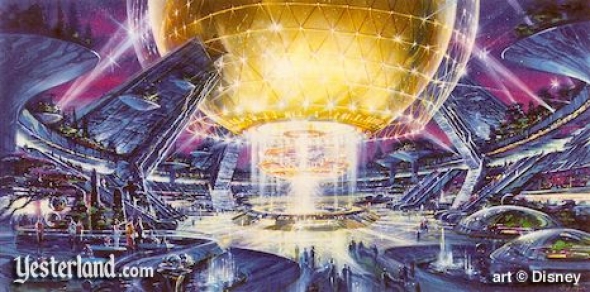
But this is a first. Long before guests even set foot in Westcot, its iconic central feature looms over the resort… and all of Anaheim. Spacestation Earth is not only meant to represent this park’s connection to EPCOT, but its differentiation from it. Unlike its white, Ray Bradbury-stylized, ’70s-influenced central sphere covered in triangular panels, Spacestation Earth is nearly twice as tall – an unthinkable 300 feet – and glowing, pulsing gold, surrounded in a supernaturally-hovering lattice of reflective metal.
The absolutely gargantuan icon is meant to send an immediate message that this park has diverged from the squeaky-clean EPCOT, criticized even in the ’90s for its vast expanses of concrete, its monumental ’80s architecture, and its cold, almost-sterile view of tomorrow. After all, this is the dawn of the New Millennium, where our view of tomorrow is much different.
Ventureport

As guests enter the park, they’re pulsed across a bridge toward Spacestation Earth, arriving at last at Ventureport – the heart of Westcot. Boarding outdoor escalators descending to the icon’s base, they’re carried down into a lush, entrenched central isle alongside waterfalls and otherworldly rockwork covered in trees and moss. Water pours from beneath the globe into the surrounding waters. This is a future at one with nature, not opposed to it, and as guests ascend into the heart of Spacestation Earth, they become part of the story of humanity’s progress in an updated reimagining of EPCOT’s own thesis attraction.
Perhaps most brilliantly, placing Spacestation Earth at the center of the park more clearly reveals its relationship to the two realms of Westcot – as in Florida, Future World and Showcase. After all, the glowing sphere here not only exemplifies the future with its spectacular design and color, but of our globe… And in fact, what surrounds this Earth is exactly that: the corners of our world…
World Showcase
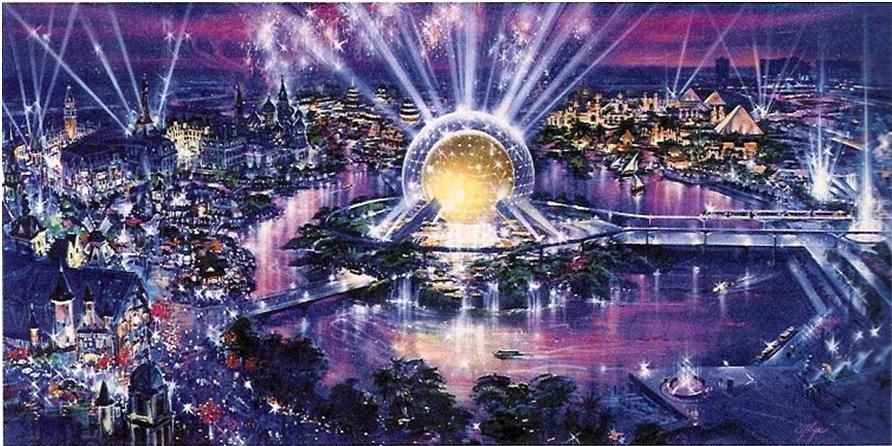
During the development of World Showcase at EPCOT Center, Disney had intended for the “World’s Fair” sponsorship model to be front-and-center, with governments from around the world stepping to sponsor cultural pavilions representing their countries (as well as housing their representative Cast Members and the design and installation of any attractions within). The number of countries that took Disney up on their offer? Zero. Instead, many of World Showcase’s pavilions were sponsored by foreign corporations tasked with representing their countries of origin.
Perhaps that’s why Westcot’s World Showcase looks quite a bit different. Rather than discrete pavilions for different countries, this World Showcase is meant to represent the Four Corners of the World in jumbled villages of international flavor. Here, there are four enormous and interconnected pavilions to explore.
- The World of Africa would be the first pavilion encountered traveling counter-clockwise around the park. Fittingly, this area would celebrate the origins of civilization, with guests’ first stops being the ancient kingdoms of the region. Passing through Egypt, guests could participate in demonstrations of agriculture, sailing, and more. The area was meant to contain a white water rafting ride down the fictional “Congobezi River,” as well as spectacular entertainment via African drummer and dance troupes. The land would gradually transition to the Middle East, and into the next corner of the globe…
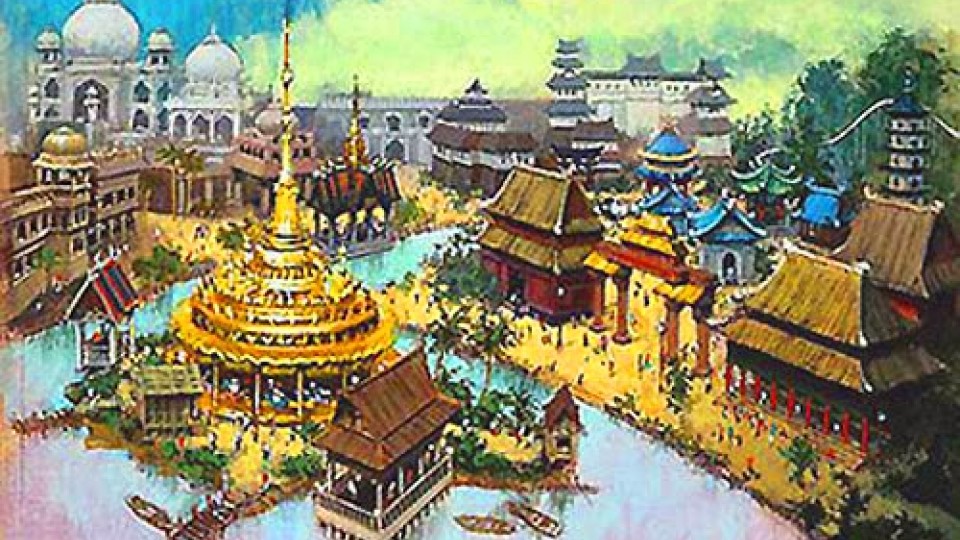
- The World of Asia would reportedly blend elements of China, Japan, and India into a timeless village of entertainment and action. In fact, it’s supposed that one of the park’s more substantial thrill rides might’ve been here, as a dragon-themed roller coaster set among the rolling Great Wall of China and traveling through “Dragon’s Teeth Mountain.”
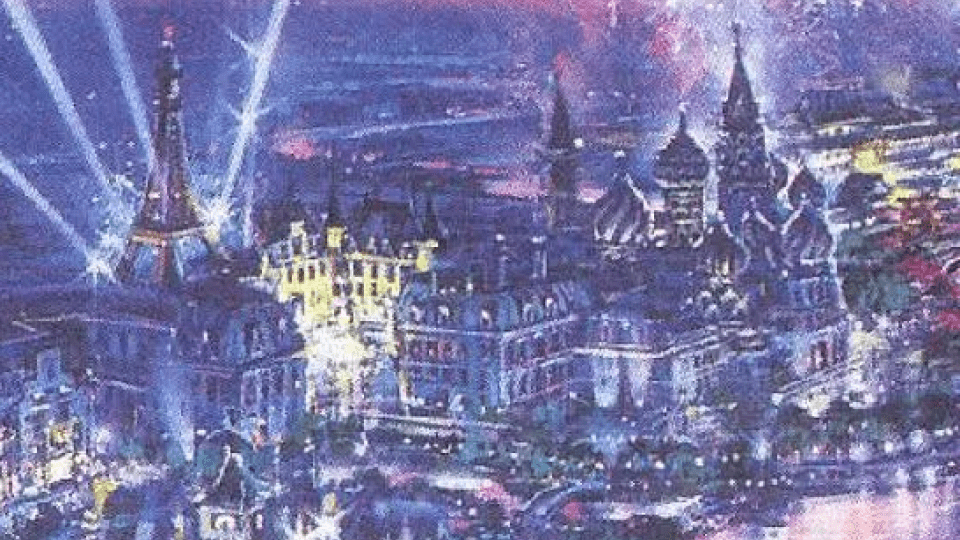
- Continuing onward, guests would find themselves in The Old World – representing the cultures, cuisines, and legends of Europe. This was rumored to be a potential landing place for the Lost Legend: The Timekeeper, tracing great European writers and philosophers in a time-traveling journey. Otherwise, the pavilion would feature a Russian show originally planned for EPCOT’s never-built pavilion, a Greek Amphitheater, and the area’s biggest draw: a “high-speed” Trans-European train simulator (an evolution of a never-built Bullet Train ride for EPCOT’s Japan) potentially set up as a James Bond-esque thrill ride across the continent. And then, Spain would transition into…
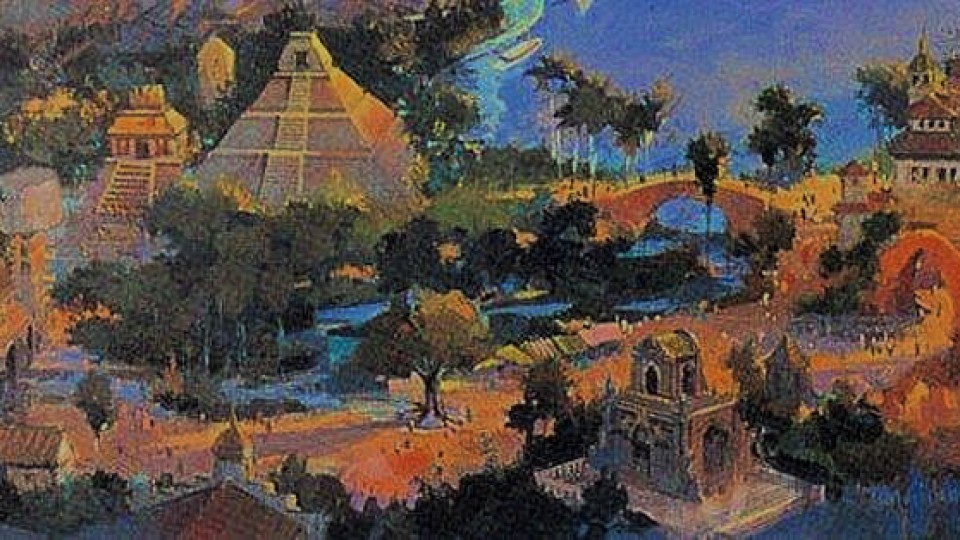
- The New World – a pavilion dedicated to the cultures, customs, stories, and styles of North and South America. Departing Spain, guests would arrive in “the New World” via the land of the Mayan and Aztec cilivizations, then explore the cultures of Mexico and Central America. A region dedicated to Canada would explore the indigenous peoples of the Great North, then on to America, where a copy of EPCOT’s American Adventure show would act as a capstone to our world travels. Meanwhile, the streets of America – perhaps represented in colonial style – would theoretically bend back toward the park’s exit, acting as a clever “prologue” to Main Street, U.S.A. – the continuing American journey!
As you can see, Westcot’s World Showcase was a clever reinvention; a way to adapt the idea of celebrating humanity and culture into a much more cohesive and collaborative style. While we could debate the “rightness” or “wrongness” of the implied “advancement” from Africa to the U.S., the idea of this exceptional World Showcase was not to advertise countries or the products of their economies, but to show how the human story is one of sharing and by the movement of people and ideas; betterment by connection.
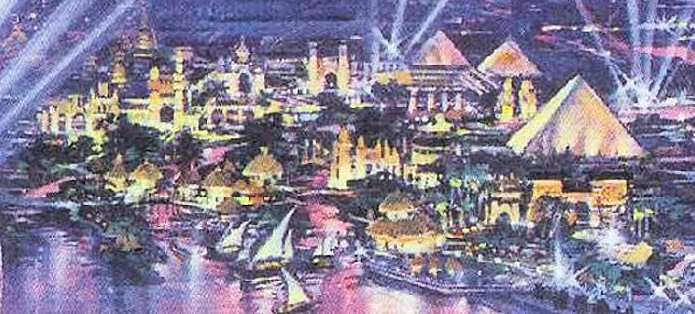
And no ride told that story like The River of Time. This ultra-attraction would’ve been the longest Disney had ever designed – 45 minutes from start to end. But most cleverly, the waterways of this “Pirates” style boat ride would bob and weave through each of the Four Corners, passing elaborate Audio-Animatronics scenes showcasing the cultures and innovations and advances of each. Imagine sailing through Africa and witnessing scenes of ancient Egypt, then sailing on through the painting of the Mona Lisa and the burning of Rome…
And like the Disneyland Railroad, the boats would dock momentarily in each pavilion, allowing guests to exit and explore… or stay on board to see the entire story unfold in one telling. And that river would flow through the park’s other realm, too…
Future World

As with World Showcase, the EPCOT mainstay of Future World was entirely reimagined for this West Coast park. Rather than discrete pavilions sponsored by mega-corporations, Westcot again developed a new way of seeing the future. Tucked away beyond the Four Corners of the Globe lie three self-contained and indoor pavilions:
- The Wonders of Life (marked by a glass pyramid) would be the park’s most imaginative pavilion, celebrating the human body, mind, and spirit. Naturally, its ride lineup would include clones of EPCOT’s Lost Legend: Body Wars, but a surprisingly clever fit for the park would’ve been a copy of the beloved Lost Legend: Journey into Imagination.
- The Wonders of Earth pavilion (with a glass greenhouse entry) would likely expand on the original idea set forth for EPCOT’s Land pavilion, focusing on biomes and habitats of our world. It likely would’ve had a version of Living with the Land, and for all we know it might’ve even been the birthplace of the Lost Legend: Soarin’!
- The Wonders of Space (topped with a glass dome and rocket) would finally provide Disney with a space-themed pavilion (planned – but never built – at EPCOT since the mid-’70s!). While we don’t know exactly what this pavilion would’ve contained, the promised “journey through the cosmos” sounds like the never-built concepts we explored in our Possibilityland: Future World feature.

There’s a real, staggering simplicity to Westcot. Reimagining (and arguably, improving upon) some of the foundational elements of EPCOT, the park’s purpose was to reinvigorate Disneyland and reinvent the tried-and-true elements of EPCOT from the perspective of the ’90s. And in that regard, it seems to have succeeded. Admittedly, the park would’ve been a true departure from Disneyland – as Epcot had been from Magic Kingdom – and would represent one of Disney’s most ambitious projects ever.
But there is no Westcot today. Why?
The writing on the wall
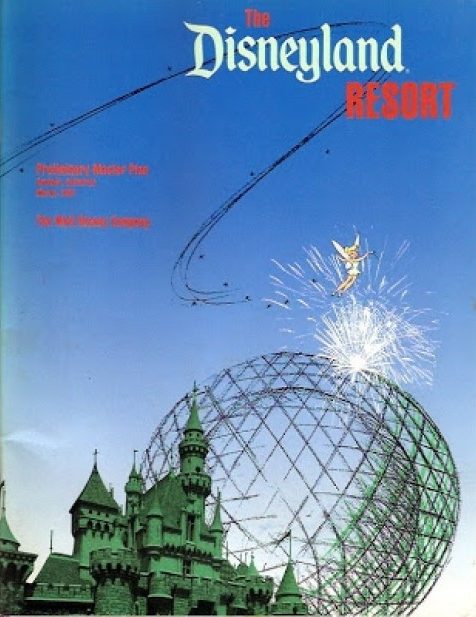
The official Master Plan for WestCOT and new Disneyland Resort was released publicly on May 8, 1991. The massive expansion was to break ground in 1993, assuring a fully operational system by 1999. Disney’s analysis asserted that the project would have led to over 25,000 new jobs and around $40 million in direct tax revenues for the city. By the New Millennium, Peoplemovers, Monorails, and shuttles would be connecting the various elements of the Disneyland Resort and its two theme parks… ! Except that the problems began before a single shovel of dirt had shifted.
Though it’s hard to imagine, Disneyland is surrounded by local, long-standing housing developments whose residents (deservedly or not) tend to resent it. The stifling traffic, the nightly fireworks, the busy holidays… It’s easy to see why in practice, Disneyland might not make the best neighbor. Adding insult to injury, several locals got ahold of the new Disneyland master plans only to find that Westcot or its accoutrements were placed on top of their homes or businesses. After all, Disney would need to acquire 100 additional acres to make this Resort a reality… something the people living on those acres hadn’t yet been asked about.
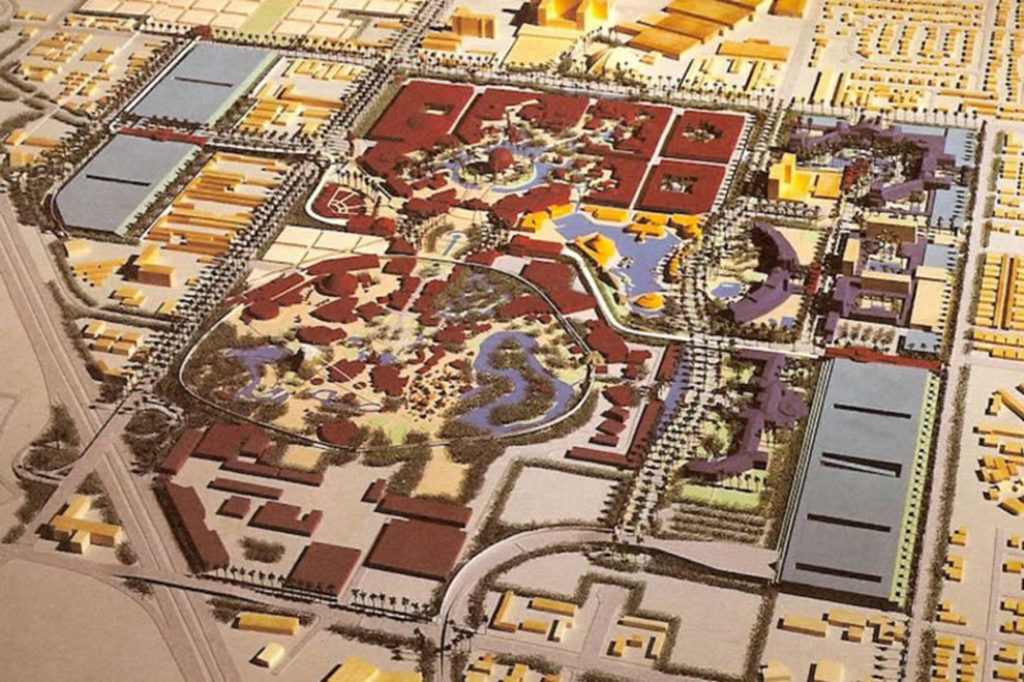
A local action committee of concerned residents (Anaheim Homeowners for Maintaining the Environment, or HOME) arose, picketing the park, passing out anti-Westcot leaflets, flooding city council meetings, and fighting back against the park. HOME took issue with Disney’s long-standing precedent of offering free tickets to employees of Anaheim’s Mayor’s Office, raising the issue as bribery.
Locals balked at the idea of increased traffic clogging the region’s streets, and Disney’s promises of building gargantuan, gas-guzzling parking garages and direct highway ramps to the resort that would rise over their backyards only worsened their tastes. To make matters even worse, Disney turned around and lobbied for $400 million in public funds to bring those garages and infrastructure improvements to life, inciting a significant pushback.
Famously, nearby residents rallied against Spacestation Earth itself… And perhaps rightly. They argued that the massive, 300-foot globe (that’s two Matterhorns stacked on top of each other) would dominate the city’s skyline, looming ominously and obnoxiously over their neighborhoods (and, if we’re being honest, Main Street, too). Disney reacted by revising the plans for the park.
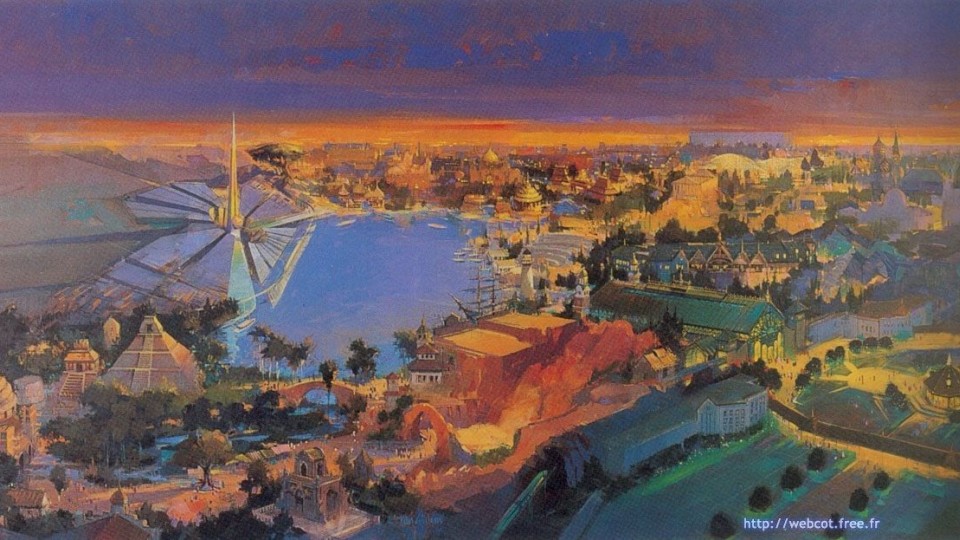
In a second batch of announcements and artwork, Disney had recrafted Spacestation Earth into a single, slim spire, slicing into the sky like a knife’s edge – a more palatable icon for locals at least… In a vague indication that they’d been too hasty, Disney released a statement in December 1991:
“Our excitement about the decision to proceed with the Disneyland Resort is tempered by the realization that many hurdles remain. Developing a project of this magnitude in southern California is expensive and extremely complex.”
And without a doubt, the park’s expense and complexity were beginning to dawn on Michael Eisner, too. Disneyland had exactly one shot at expanding into a resort, with the second gate filling its available real estate (and then some). He had to get this right… Westcot’s estimated price tag allegedly ballooned to over $3 billion (with another billion needed for resort and infrastructure alone). As seemingly insurmountable hurdles collected one on top of another, the light at the end of the tunnel seemed to be getting farther and farther away…
Could Disney have plowed through? Probably… But then something happened that changed everything at the Walt Disney Company forever…


